Critical Appraisal Report: Evaluation of Public Health Research Papers
VerifiedAdded on 2022/08/11
|11
|2625
|31
Report
AI Summary
This report critically appraises two research papers. The first paper by Dockrell et al. (2013) examines attitudes towards e-cigarettes in Great Britain, analyzing prevalence and potential as a smoking alternative. It evaluates the study's methodology, including survey design and statistical analysis, while also acknowledging limitations like sample representativeness. The second paper by Gesser-Edelsburg et al. (2018) investigates the correction of misinformation by health organizations during measles outbreaks, assessing the effectiveness of interventions on vaccination attitudes. It explores the research design, including mixed methods, participant selection, and statistical techniques, and discusses the study's strengths and weaknesses, such as sample limitations and the impact of healthcare worker participation. Both appraisals consider the papers' contributions to public health knowledge, methodological rigor, and implications for future research.
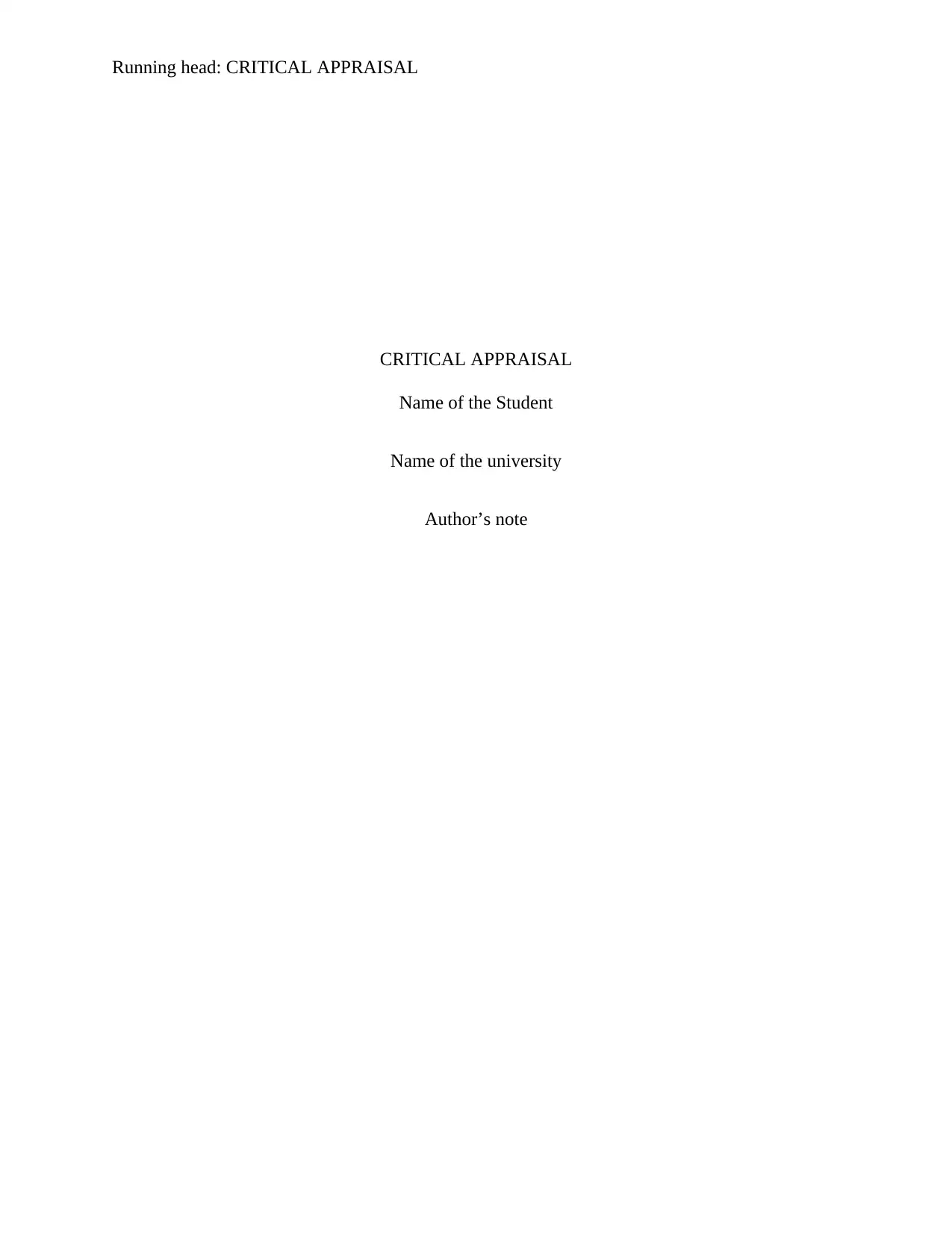
Running head: CRITICAL APPRAISAL
CRITICAL APPRAISAL
Name of the Student
Name of the university
Author’s note
CRITICAL APPRAISAL
Name of the Student
Name of the university
Author’s note
Paraphrase This Document
Need a fresh take? Get an instant paraphrase of this document with our AI Paraphraser
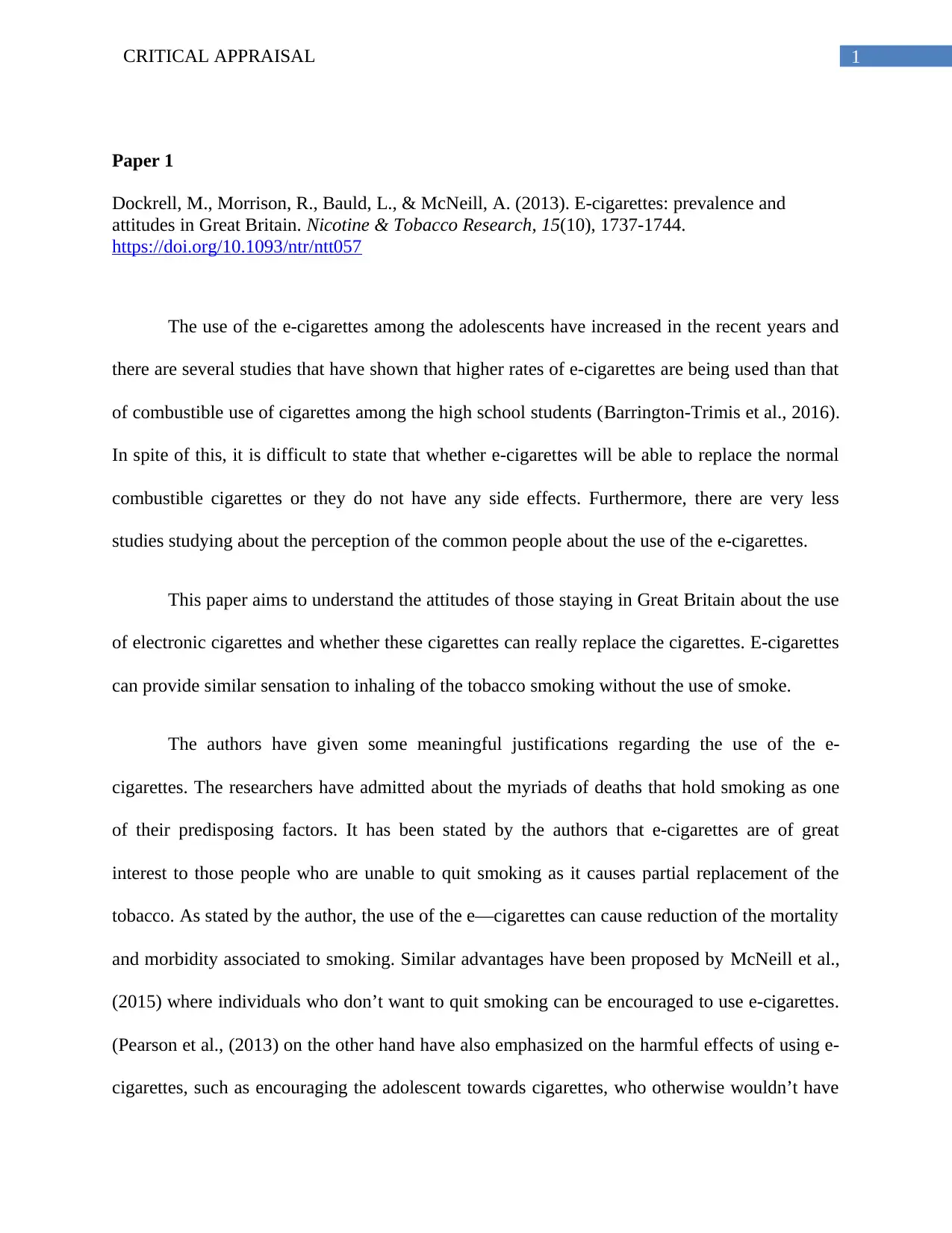
1CRITICAL APPRAISAL
Paper 1
Dockrell, M., Morrison, R., Bauld, L., & McNeill, A. (2013). E-cigarettes: prevalence and
attitudes in Great Britain. Nicotine & Tobacco Research, 15(10), 1737-1744.
https://doi.org/10.1093/ntr/ntt057
The use of the e-cigarettes among the adolescents have increased in the recent years and
there are several studies that have shown that higher rates of e-cigarettes are being used than that
of combustible use of cigarettes among the high school students (Barrington-Trimis et al., 2016).
In spite of this, it is difficult to state that whether e-cigarettes will be able to replace the normal
combustible cigarettes or they do not have any side effects. Furthermore, there are very less
studies studying about the perception of the common people about the use of the e-cigarettes.
This paper aims to understand the attitudes of those staying in Great Britain about the use
of electronic cigarettes and whether these cigarettes can really replace the cigarettes. E-cigarettes
can provide similar sensation to inhaling of the tobacco smoking without the use of smoke.
The authors have given some meaningful justifications regarding the use of the e-
cigarettes. The researchers have admitted about the myriads of deaths that hold smoking as one
of their predisposing factors. It has been stated by the authors that e-cigarettes are of great
interest to those people who are unable to quit smoking as it causes partial replacement of the
tobacco. As stated by the author, the use of the e—cigarettes can cause reduction of the mortality
and morbidity associated to smoking. Similar advantages have been proposed by McNeill et al.,
(2015) where individuals who don’t want to quit smoking can be encouraged to use e-cigarettes.
(Pearson et al., (2013) on the other hand have also emphasized on the harmful effects of using e-
cigarettes, such as encouraging the adolescent towards cigarettes, who otherwise wouldn’t have
Paper 1
Dockrell, M., Morrison, R., Bauld, L., & McNeill, A. (2013). E-cigarettes: prevalence and
attitudes in Great Britain. Nicotine & Tobacco Research, 15(10), 1737-1744.
https://doi.org/10.1093/ntr/ntt057
The use of the e-cigarettes among the adolescents have increased in the recent years and
there are several studies that have shown that higher rates of e-cigarettes are being used than that
of combustible use of cigarettes among the high school students (Barrington-Trimis et al., 2016).
In spite of this, it is difficult to state that whether e-cigarettes will be able to replace the normal
combustible cigarettes or they do not have any side effects. Furthermore, there are very less
studies studying about the perception of the common people about the use of the e-cigarettes.
This paper aims to understand the attitudes of those staying in Great Britain about the use
of electronic cigarettes and whether these cigarettes can really replace the cigarettes. E-cigarettes
can provide similar sensation to inhaling of the tobacco smoking without the use of smoke.
The authors have given some meaningful justifications regarding the use of the e-
cigarettes. The researchers have admitted about the myriads of deaths that hold smoking as one
of their predisposing factors. It has been stated by the authors that e-cigarettes are of great
interest to those people who are unable to quit smoking as it causes partial replacement of the
tobacco. As stated by the author, the use of the e—cigarettes can cause reduction of the mortality
and morbidity associated to smoking. Similar advantages have been proposed by McNeill et al.,
(2015) where individuals who don’t want to quit smoking can be encouraged to use e-cigarettes.
(Pearson et al., (2013) on the other hand have also emphasized on the harmful effects of using e-
cigarettes, such as encouraging the adolescent towards cigarettes, who otherwise wouldn’t have
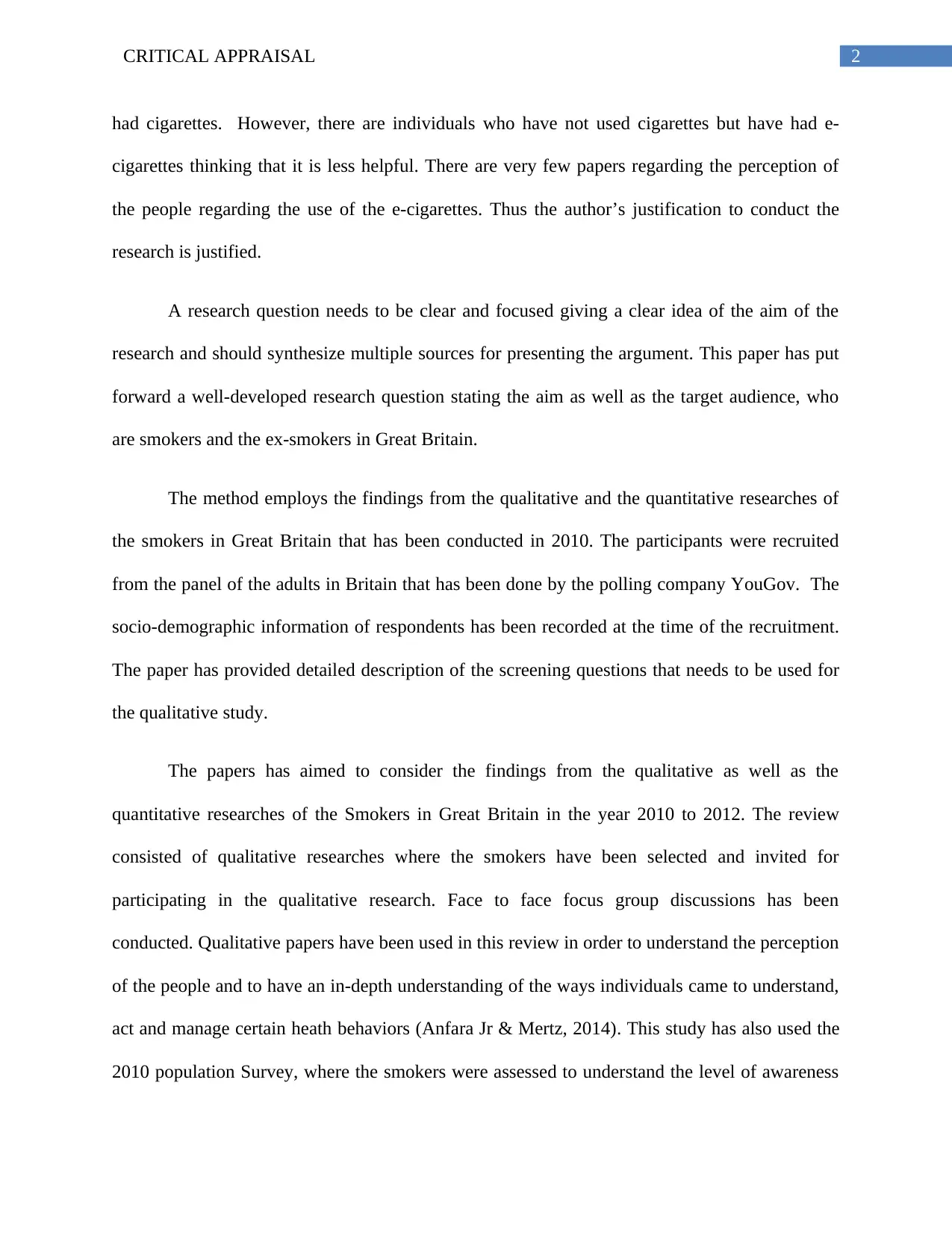
2CRITICAL APPRAISAL
had cigarettes. However, there are individuals who have not used cigarettes but have had e-
cigarettes thinking that it is less helpful. There are very few papers regarding the perception of
the people regarding the use of the e-cigarettes. Thus the author’s justification to conduct the
research is justified.
A research question needs to be clear and focused giving a clear idea of the aim of the
research and should synthesize multiple sources for presenting the argument. This paper has put
forward a well-developed research question stating the aim as well as the target audience, who
are smokers and the ex-smokers in Great Britain.
The method employs the findings from the qualitative and the quantitative researches of
the smokers in Great Britain that has been conducted in 2010. The participants were recruited
from the panel of the adults in Britain that has been done by the polling company YouGov. The
socio-demographic information of respondents has been recorded at the time of the recruitment.
The paper has provided detailed description of the screening questions that needs to be used for
the qualitative study.
The papers has aimed to consider the findings from the qualitative as well as the
quantitative researches of the Smokers in Great Britain in the year 2010 to 2012. The review
consisted of qualitative researches where the smokers have been selected and invited for
participating in the qualitative research. Face to face focus group discussions has been
conducted. Qualitative papers have been used in this review in order to understand the perception
of the people and to have an in-depth understanding of the ways individuals came to understand,
act and manage certain heath behaviors (Anfara Jr & Mertz, 2014). This study has also used the
2010 population Survey, where the smokers were assessed to understand the level of awareness
had cigarettes. However, there are individuals who have not used cigarettes but have had e-
cigarettes thinking that it is less helpful. There are very few papers regarding the perception of
the people regarding the use of the e-cigarettes. Thus the author’s justification to conduct the
research is justified.
A research question needs to be clear and focused giving a clear idea of the aim of the
research and should synthesize multiple sources for presenting the argument. This paper has put
forward a well-developed research question stating the aim as well as the target audience, who
are smokers and the ex-smokers in Great Britain.
The method employs the findings from the qualitative and the quantitative researches of
the smokers in Great Britain that has been conducted in 2010. The participants were recruited
from the panel of the adults in Britain that has been done by the polling company YouGov. The
socio-demographic information of respondents has been recorded at the time of the recruitment.
The paper has provided detailed description of the screening questions that needs to be used for
the qualitative study.
The papers has aimed to consider the findings from the qualitative as well as the
quantitative researches of the Smokers in Great Britain in the year 2010 to 2012. The review
consisted of qualitative researches where the smokers have been selected and invited for
participating in the qualitative research. Face to face focus group discussions has been
conducted. Qualitative papers have been used in this review in order to understand the perception
of the people and to have an in-depth understanding of the ways individuals came to understand,
act and manage certain heath behaviors (Anfara Jr & Mertz, 2014). This study has also used the
2010 population Survey, where the smokers were assessed to understand the level of awareness
⊘ This is a preview!⊘
Do you want full access?
Subscribe today to unlock all pages.

Trusted by 1+ million students worldwide
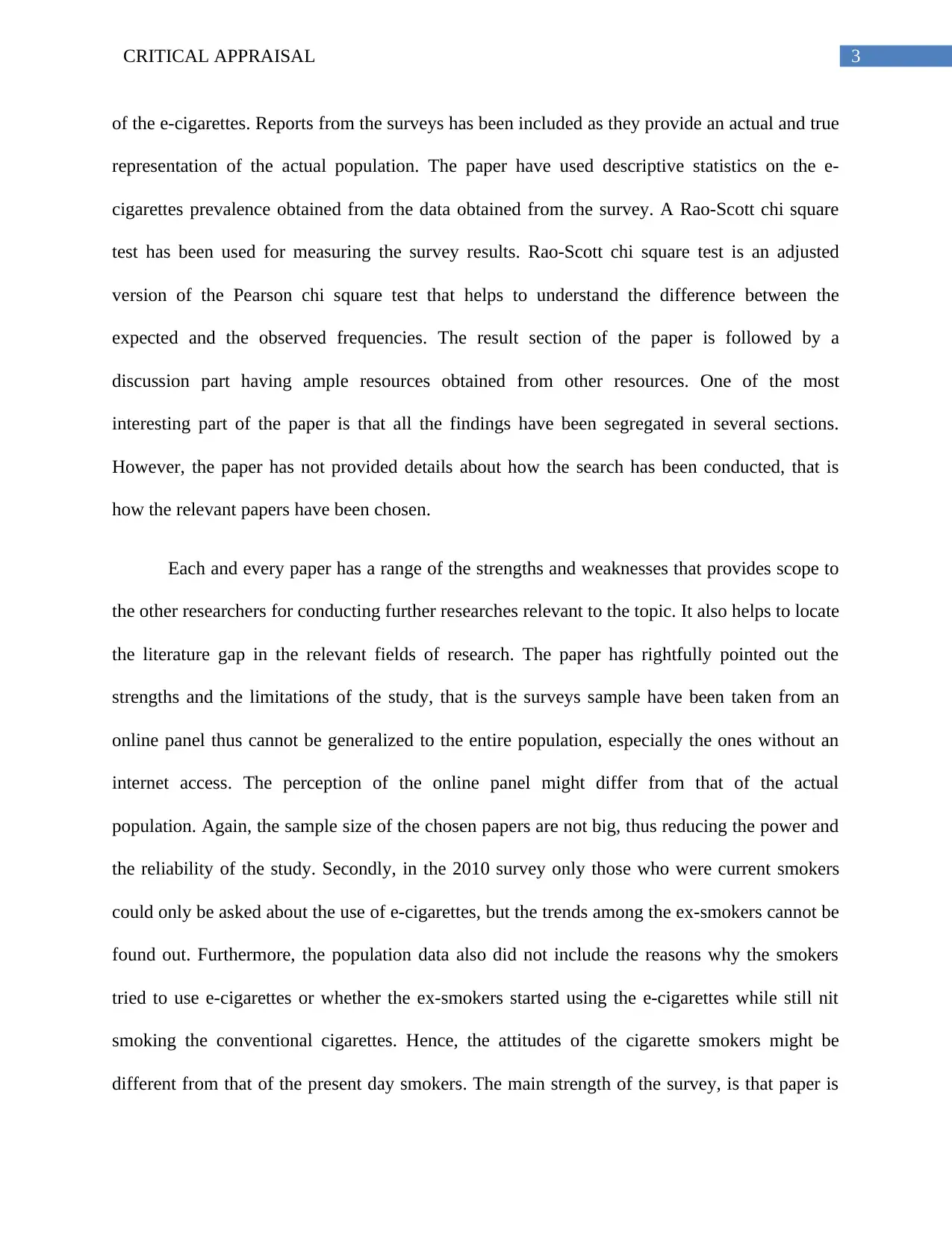
3CRITICAL APPRAISAL
of the e-cigarettes. Reports from the surveys has been included as they provide an actual and true
representation of the actual population. The paper have used descriptive statistics on the e-
cigarettes prevalence obtained from the data obtained from the survey. A Rao-Scott chi square
test has been used for measuring the survey results. Rao-Scott chi square test is an adjusted
version of the Pearson chi square test that helps to understand the difference between the
expected and the observed frequencies. The result section of the paper is followed by a
discussion part having ample resources obtained from other resources. One of the most
interesting part of the paper is that all the findings have been segregated in several sections.
However, the paper has not provided details about how the search has been conducted, that is
how the relevant papers have been chosen.
Each and every paper has a range of the strengths and weaknesses that provides scope to
the other researchers for conducting further researches relevant to the topic. It also helps to locate
the literature gap in the relevant fields of research. The paper has rightfully pointed out the
strengths and the limitations of the study, that is the surveys sample have been taken from an
online panel thus cannot be generalized to the entire population, especially the ones without an
internet access. The perception of the online panel might differ from that of the actual
population. Again, the sample size of the chosen papers are not big, thus reducing the power and
the reliability of the study. Secondly, in the 2010 survey only those who were current smokers
could only be asked about the use of e-cigarettes, but the trends among the ex-smokers cannot be
found out. Furthermore, the population data also did not include the reasons why the smokers
tried to use e-cigarettes or whether the ex-smokers started using the e-cigarettes while still nit
smoking the conventional cigarettes. Hence, the attitudes of the cigarette smokers might be
different from that of the present day smokers. The main strength of the survey, is that paper is
of the e-cigarettes. Reports from the surveys has been included as they provide an actual and true
representation of the actual population. The paper have used descriptive statistics on the e-
cigarettes prevalence obtained from the data obtained from the survey. A Rao-Scott chi square
test has been used for measuring the survey results. Rao-Scott chi square test is an adjusted
version of the Pearson chi square test that helps to understand the difference between the
expected and the observed frequencies. The result section of the paper is followed by a
discussion part having ample resources obtained from other resources. One of the most
interesting part of the paper is that all the findings have been segregated in several sections.
However, the paper has not provided details about how the search has been conducted, that is
how the relevant papers have been chosen.
Each and every paper has a range of the strengths and weaknesses that provides scope to
the other researchers for conducting further researches relevant to the topic. It also helps to locate
the literature gap in the relevant fields of research. The paper has rightfully pointed out the
strengths and the limitations of the study, that is the surveys sample have been taken from an
online panel thus cannot be generalized to the entire population, especially the ones without an
internet access. The perception of the online panel might differ from that of the actual
population. Again, the sample size of the chosen papers are not big, thus reducing the power and
the reliability of the study. Secondly, in the 2010 survey only those who were current smokers
could only be asked about the use of e-cigarettes, but the trends among the ex-smokers cannot be
found out. Furthermore, the population data also did not include the reasons why the smokers
tried to use e-cigarettes or whether the ex-smokers started using the e-cigarettes while still nit
smoking the conventional cigarettes. Hence, the attitudes of the cigarette smokers might be
different from that of the present day smokers. The main strength of the survey, is that paper is
Paraphrase This Document
Need a fresh take? Get an instant paraphrase of this document with our AI Paraphraser

4CRITICAL APPRAISAL
apt for giving up-to-date information to the policy makers with data for a large sample of British
adults.
apt for giving up-to-date information to the policy makers with data for a large sample of British
adults.
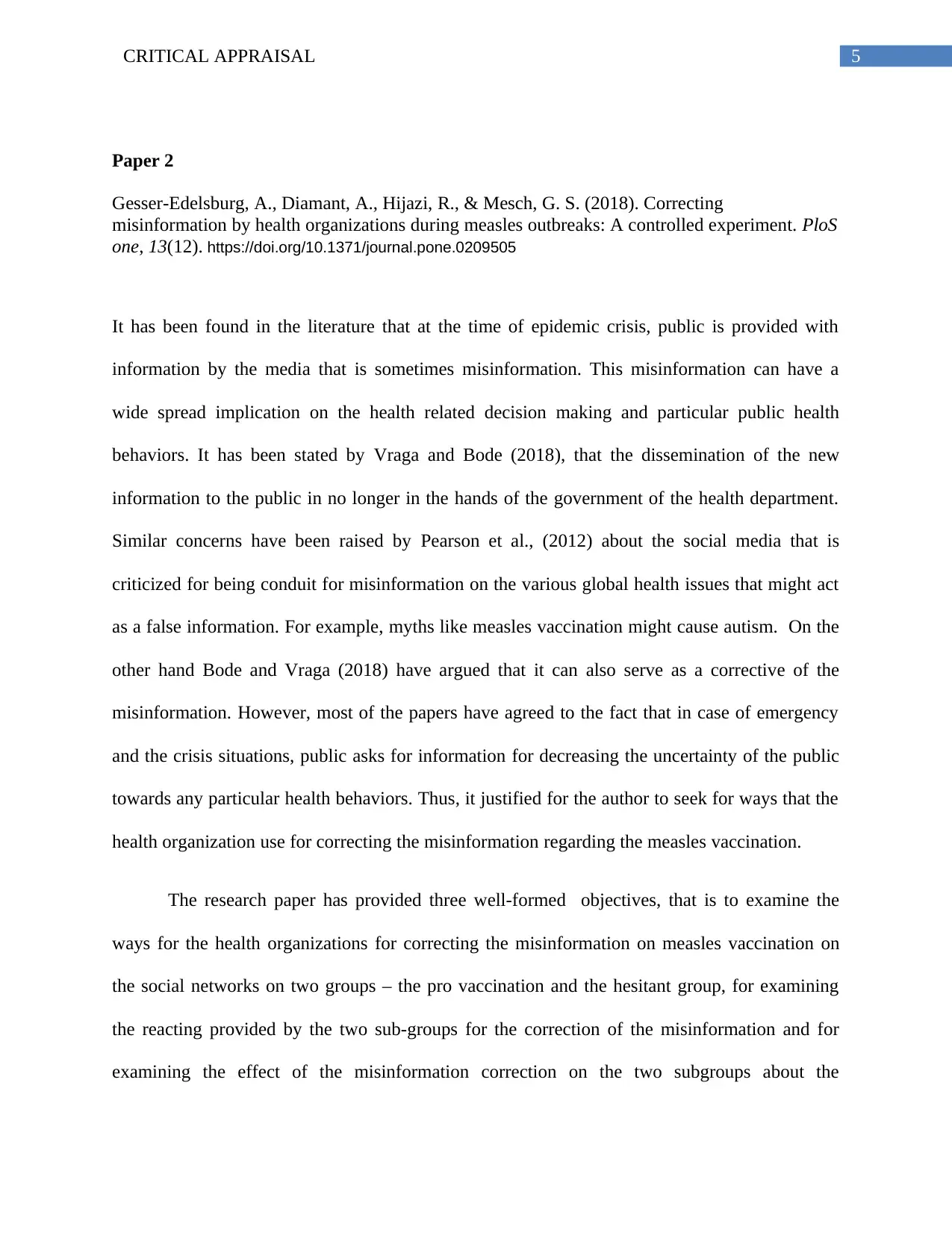
5CRITICAL APPRAISAL
Paper 2
Gesser-Edelsburg, A., Diamant, A., Hijazi, R., & Mesch, G. S. (2018). Correcting
misinformation by health organizations during measles outbreaks: A controlled experiment. PloS
one, 13(12). https://doi.org/10.1371/journal.pone.0209505
It has been found in the literature that at the time of epidemic crisis, public is provided with
information by the media that is sometimes misinformation. This misinformation can have a
wide spread implication on the health related decision making and particular public health
behaviors. It has been stated by Vraga and Bode (2018), that the dissemination of the new
information to the public in no longer in the hands of the government of the health department.
Similar concerns have been raised by Pearson et al., (2012) about the social media that is
criticized for being conduit for misinformation on the various global health issues that might act
as a false information. For example, myths like measles vaccination might cause autism. On the
other hand Bode and Vraga (2018) have argued that it can also serve as a corrective of the
misinformation. However, most of the papers have agreed to the fact that in case of emergency
and the crisis situations, public asks for information for decreasing the uncertainty of the public
towards any particular health behaviors. Thus, it justified for the author to seek for ways that the
health organization use for correcting the misinformation regarding the measles vaccination.
The research paper has provided three well-formed objectives, that is to examine the
ways for the health organizations for correcting the misinformation on measles vaccination on
the social networks on two groups – the pro vaccination and the hesitant group, for examining
the reacting provided by the two sub-groups for the correction of the misinformation and for
examining the effect of the misinformation correction on the two subgroups about the
Paper 2
Gesser-Edelsburg, A., Diamant, A., Hijazi, R., & Mesch, G. S. (2018). Correcting
misinformation by health organizations during measles outbreaks: A controlled experiment. PloS
one, 13(12). https://doi.org/10.1371/journal.pone.0209505
It has been found in the literature that at the time of epidemic crisis, public is provided with
information by the media that is sometimes misinformation. This misinformation can have a
wide spread implication on the health related decision making and particular public health
behaviors. It has been stated by Vraga and Bode (2018), that the dissemination of the new
information to the public in no longer in the hands of the government of the health department.
Similar concerns have been raised by Pearson et al., (2012) about the social media that is
criticized for being conduit for misinformation on the various global health issues that might act
as a false information. For example, myths like measles vaccination might cause autism. On the
other hand Bode and Vraga (2018) have argued that it can also serve as a corrective of the
misinformation. However, most of the papers have agreed to the fact that in case of emergency
and the crisis situations, public asks for information for decreasing the uncertainty of the public
towards any particular health behaviors. Thus, it justified for the author to seek for ways that the
health organization use for correcting the misinformation regarding the measles vaccination.
The research paper has provided three well-formed objectives, that is to examine the
ways for the health organizations for correcting the misinformation on measles vaccination on
the social networks on two groups – the pro vaccination and the hesitant group, for examining
the reacting provided by the two sub-groups for the correction of the misinformation and for
examining the effect of the misinformation correction on the two subgroups about the
⊘ This is a preview!⊘
Do you want full access?
Subscribe today to unlock all pages.

Trusted by 1+ million students worldwide
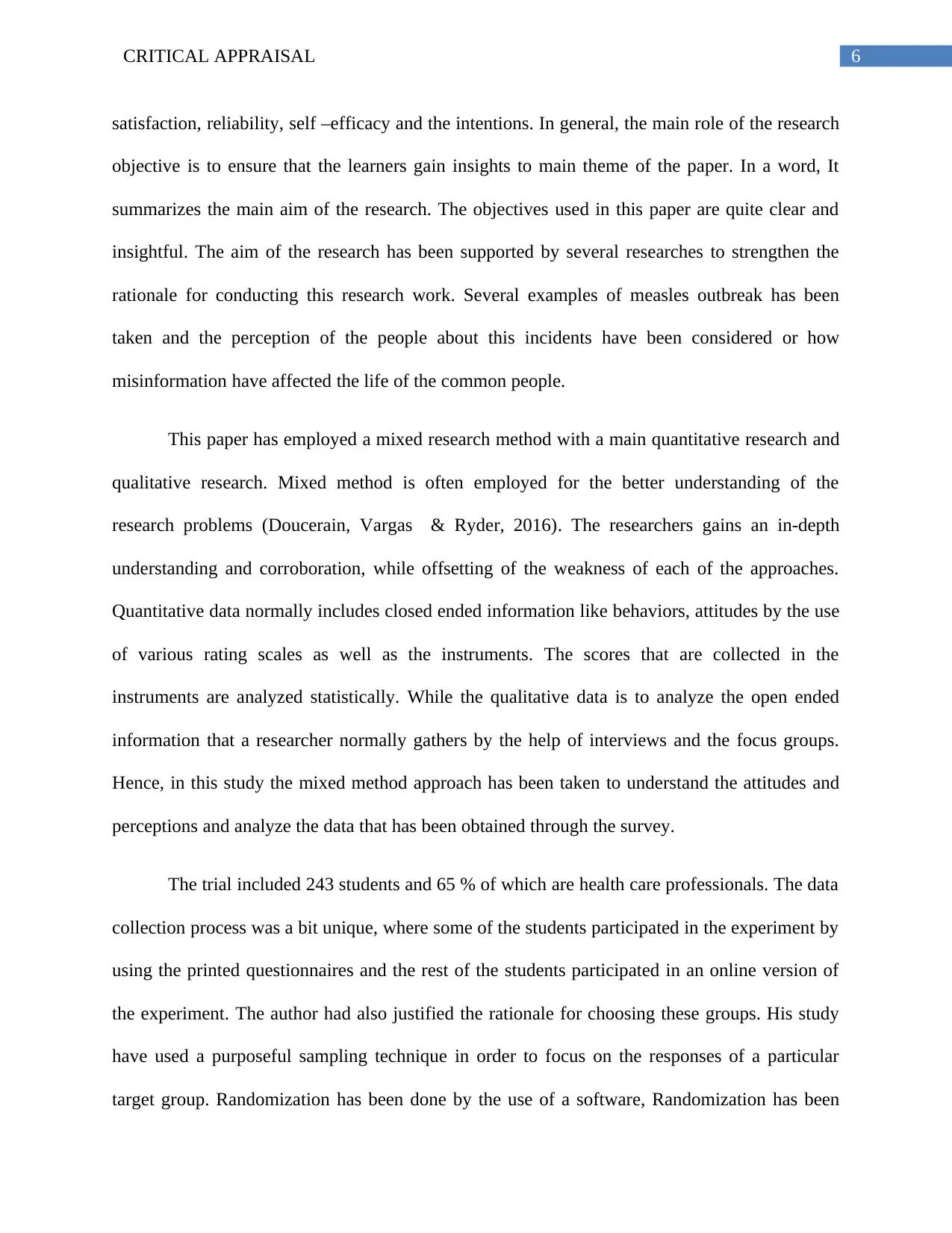
6CRITICAL APPRAISAL
satisfaction, reliability, self –efficacy and the intentions. In general, the main role of the research
objective is to ensure that the learners gain insights to main theme of the paper. In a word, It
summarizes the main aim of the research. The objectives used in this paper are quite clear and
insightful. The aim of the research has been supported by several researches to strengthen the
rationale for conducting this research work. Several examples of measles outbreak has been
taken and the perception of the people about this incidents have been considered or how
misinformation have affected the life of the common people.
This paper has employed a mixed research method with a main quantitative research and
qualitative research. Mixed method is often employed for the better understanding of the
research problems (Doucerain, Vargas & Ryder, 2016). The researchers gains an in-depth
understanding and corroboration, while offsetting of the weakness of each of the approaches.
Quantitative data normally includes closed ended information like behaviors, attitudes by the use
of various rating scales as well as the instruments. The scores that are collected in the
instruments are analyzed statistically. While the qualitative data is to analyze the open ended
information that a researcher normally gathers by the help of interviews and the focus groups.
Hence, in this study the mixed method approach has been taken to understand the attitudes and
perceptions and analyze the data that has been obtained through the survey.
The trial included 243 students and 65 % of which are health care professionals. The data
collection process was a bit unique, where some of the students participated in the experiment by
using the printed questionnaires and the rest of the students participated in an online version of
the experiment. The author had also justified the rationale for choosing these groups. His study
have used a purposeful sampling technique in order to focus on the responses of a particular
target group. Randomization has been done by the use of a software, Randomization has been
satisfaction, reliability, self –efficacy and the intentions. In general, the main role of the research
objective is to ensure that the learners gain insights to main theme of the paper. In a word, It
summarizes the main aim of the research. The objectives used in this paper are quite clear and
insightful. The aim of the research has been supported by several researches to strengthen the
rationale for conducting this research work. Several examples of measles outbreak has been
taken and the perception of the people about this incidents have been considered or how
misinformation have affected the life of the common people.
This paper has employed a mixed research method with a main quantitative research and
qualitative research. Mixed method is often employed for the better understanding of the
research problems (Doucerain, Vargas & Ryder, 2016). The researchers gains an in-depth
understanding and corroboration, while offsetting of the weakness of each of the approaches.
Quantitative data normally includes closed ended information like behaviors, attitudes by the use
of various rating scales as well as the instruments. The scores that are collected in the
instruments are analyzed statistically. While the qualitative data is to analyze the open ended
information that a researcher normally gathers by the help of interviews and the focus groups.
Hence, in this study the mixed method approach has been taken to understand the attitudes and
perceptions and analyze the data that has been obtained through the survey.
The trial included 243 students and 65 % of which are health care professionals. The data
collection process was a bit unique, where some of the students participated in the experiment by
using the printed questionnaires and the rest of the students participated in an online version of
the experiment. The author had also justified the rationale for choosing these groups. His study
have used a purposeful sampling technique in order to focus on the responses of a particular
target group. Randomization has been done by the use of a software, Randomization has been
Paraphrase This Document
Need a fresh take? Get an instant paraphrase of this document with our AI Paraphraser
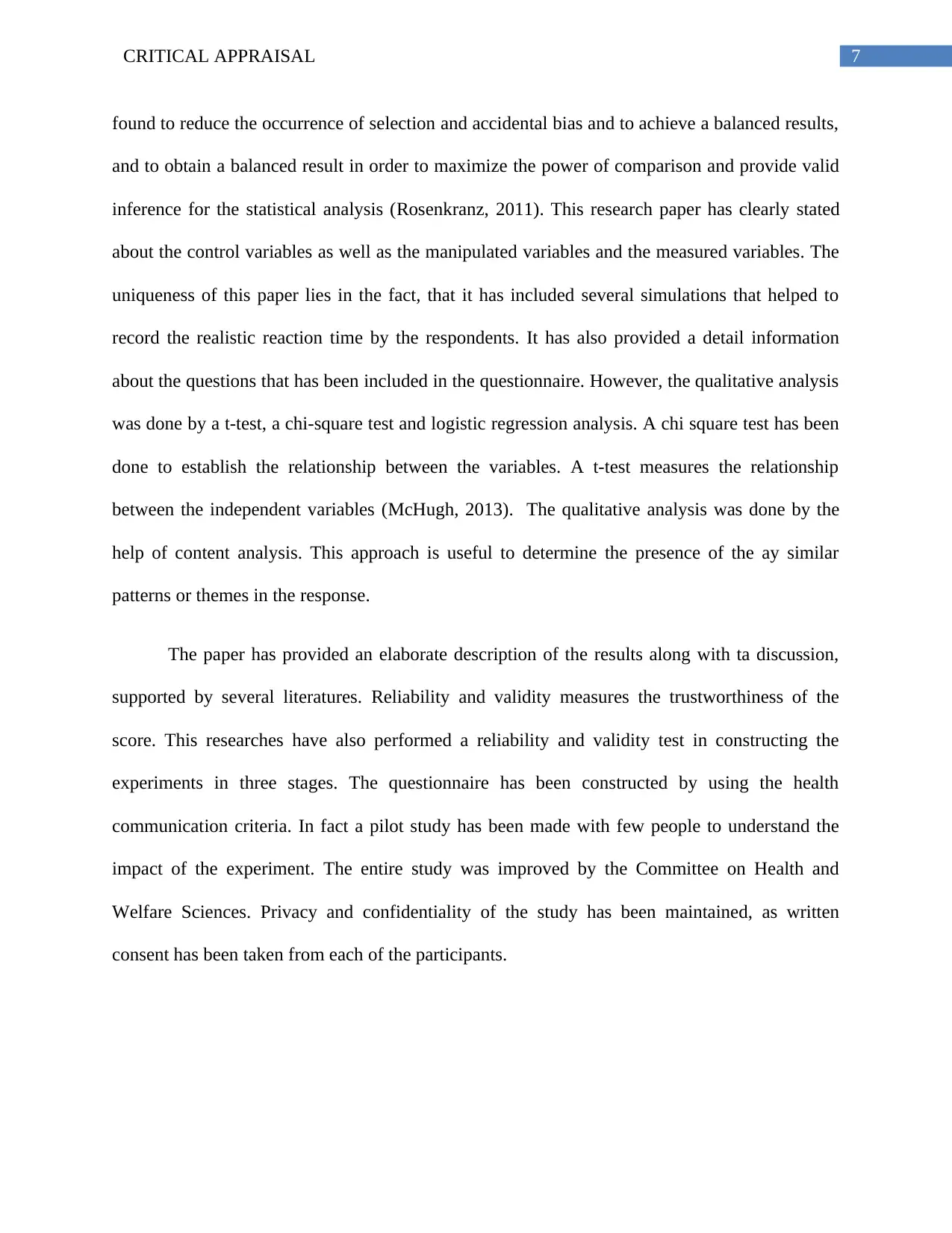
7CRITICAL APPRAISAL
found to reduce the occurrence of selection and accidental bias and to achieve a balanced results,
and to obtain a balanced result in order to maximize the power of comparison and provide valid
inference for the statistical analysis (Rosenkranz, 2011). This research paper has clearly stated
about the control variables as well as the manipulated variables and the measured variables. The
uniqueness of this paper lies in the fact, that it has included several simulations that helped to
record the realistic reaction time by the respondents. It has also provided a detail information
about the questions that has been included in the questionnaire. However, the qualitative analysis
was done by a t-test, a chi-square test and logistic regression analysis. A chi square test has been
done to establish the relationship between the variables. A t-test measures the relationship
between the independent variables (McHugh, 2013). The qualitative analysis was done by the
help of content analysis. This approach is useful to determine the presence of the ay similar
patterns or themes in the response.
The paper has provided an elaborate description of the results along with ta discussion,
supported by several literatures. Reliability and validity measures the trustworthiness of the
score. This researches have also performed a reliability and validity test in constructing the
experiments in three stages. The questionnaire has been constructed by using the health
communication criteria. In fact a pilot study has been made with few people to understand the
impact of the experiment. The entire study was improved by the Committee on Health and
Welfare Sciences. Privacy and confidentiality of the study has been maintained, as written
consent has been taken from each of the participants.
found to reduce the occurrence of selection and accidental bias and to achieve a balanced results,
and to obtain a balanced result in order to maximize the power of comparison and provide valid
inference for the statistical analysis (Rosenkranz, 2011). This research paper has clearly stated
about the control variables as well as the manipulated variables and the measured variables. The
uniqueness of this paper lies in the fact, that it has included several simulations that helped to
record the realistic reaction time by the respondents. It has also provided a detail information
about the questions that has been included in the questionnaire. However, the qualitative analysis
was done by a t-test, a chi-square test and logistic regression analysis. A chi square test has been
done to establish the relationship between the variables. A t-test measures the relationship
between the independent variables (McHugh, 2013). The qualitative analysis was done by the
help of content analysis. This approach is useful to determine the presence of the ay similar
patterns or themes in the response.
The paper has provided an elaborate description of the results along with ta discussion,
supported by several literatures. Reliability and validity measures the trustworthiness of the
score. This researches have also performed a reliability and validity test in constructing the
experiments in three stages. The questionnaire has been constructed by using the health
communication criteria. In fact a pilot study has been made with few people to understand the
impact of the experiment. The entire study was improved by the Committee on Health and
Welfare Sciences. Privacy and confidentiality of the study has been maintained, as written
consent has been taken from each of the participants.
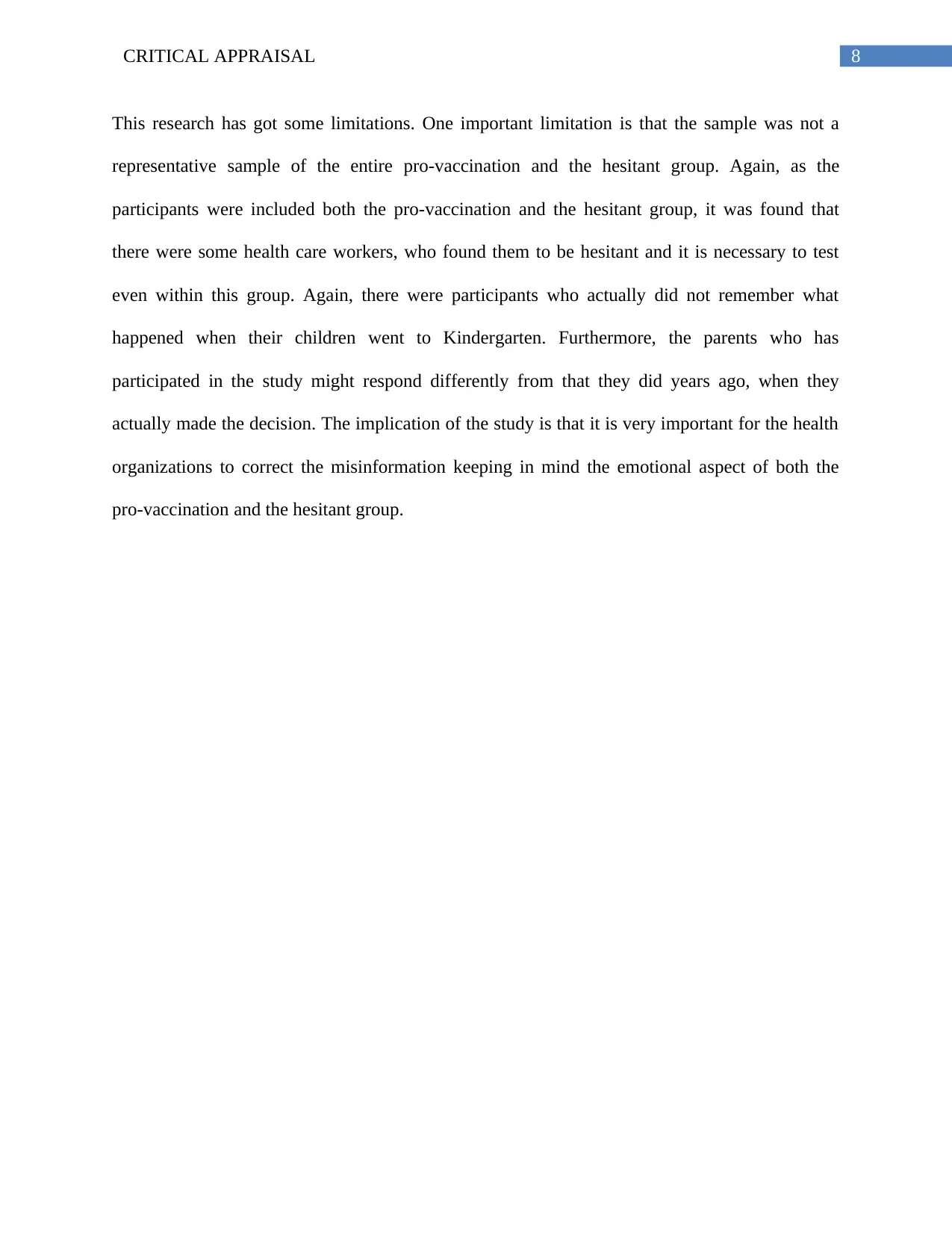
8CRITICAL APPRAISAL
This research has got some limitations. One important limitation is that the sample was not a
representative sample of the entire pro-vaccination and the hesitant group. Again, as the
participants were included both the pro-vaccination and the hesitant group, it was found that
there were some health care workers, who found them to be hesitant and it is necessary to test
even within this group. Again, there were participants who actually did not remember what
happened when their children went to Kindergarten. Furthermore, the parents who has
participated in the study might respond differently from that they did years ago, when they
actually made the decision. The implication of the study is that it is very important for the health
organizations to correct the misinformation keeping in mind the emotional aspect of both the
pro-vaccination and the hesitant group.
This research has got some limitations. One important limitation is that the sample was not a
representative sample of the entire pro-vaccination and the hesitant group. Again, as the
participants were included both the pro-vaccination and the hesitant group, it was found that
there were some health care workers, who found them to be hesitant and it is necessary to test
even within this group. Again, there were participants who actually did not remember what
happened when their children went to Kindergarten. Furthermore, the parents who has
participated in the study might respond differently from that they did years ago, when they
actually made the decision. The implication of the study is that it is very important for the health
organizations to correct the misinformation keeping in mind the emotional aspect of both the
pro-vaccination and the hesitant group.
⊘ This is a preview!⊘
Do you want full access?
Subscribe today to unlock all pages.

Trusted by 1+ million students worldwide
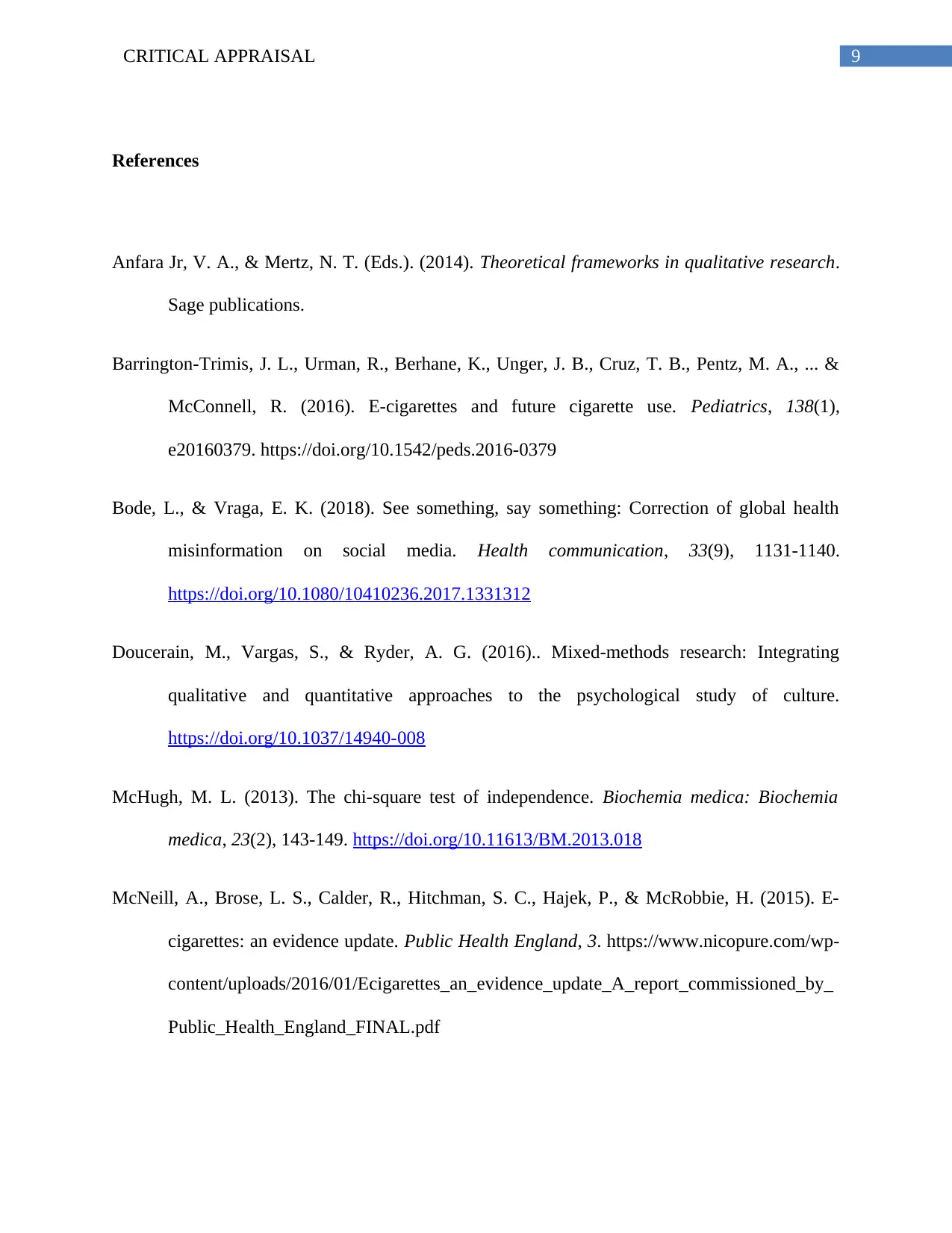
9CRITICAL APPRAISAL
References
Anfara Jr, V. A., & Mertz, N. T. (Eds.). (2014). Theoretical frameworks in qualitative research.
Sage publications.
Barrington-Trimis, J. L., Urman, R., Berhane, K., Unger, J. B., Cruz, T. B., Pentz, M. A., ... &
McConnell, R. (2016). E-cigarettes and future cigarette use. Pediatrics, 138(1),
e20160379. https://doi.org/10.1542/peds.2016-0379
Bode, L., & Vraga, E. K. (2018). See something, say something: Correction of global health
misinformation on social media. Health communication, 33(9), 1131-1140.
https://doi.org/10.1080/10410236.2017.1331312
Doucerain, M., Vargas, S., & Ryder, A. G. (2016).. Mixed-methods research: Integrating
qualitative and quantitative approaches to the psychological study of culture.
https://doi.org/10.1037/14940-008
McHugh, M. L. (2013). The chi-square test of independence. Biochemia medica: Biochemia
medica, 23(2), 143-149. https://doi.org/10.11613/BM.2013.018
McNeill, A., Brose, L. S., Calder, R., Hitchman, S. C., Hajek, P., & McRobbie, H. (2015). E-
cigarettes: an evidence update. Public Health England, 3. https://www.nicopure.com/wp-
content/uploads/2016/01/Ecigarettes_an_evidence_update_A_report_commissioned_by_
Public_Health_England_FINAL.pdf
References
Anfara Jr, V. A., & Mertz, N. T. (Eds.). (2014). Theoretical frameworks in qualitative research.
Sage publications.
Barrington-Trimis, J. L., Urman, R., Berhane, K., Unger, J. B., Cruz, T. B., Pentz, M. A., ... &
McConnell, R. (2016). E-cigarettes and future cigarette use. Pediatrics, 138(1),
e20160379. https://doi.org/10.1542/peds.2016-0379
Bode, L., & Vraga, E. K. (2018). See something, say something: Correction of global health
misinformation on social media. Health communication, 33(9), 1131-1140.
https://doi.org/10.1080/10410236.2017.1331312
Doucerain, M., Vargas, S., & Ryder, A. G. (2016).. Mixed-methods research: Integrating
qualitative and quantitative approaches to the psychological study of culture.
https://doi.org/10.1037/14940-008
McHugh, M. L. (2013). The chi-square test of independence. Biochemia medica: Biochemia
medica, 23(2), 143-149. https://doi.org/10.11613/BM.2013.018
McNeill, A., Brose, L. S., Calder, R., Hitchman, S. C., Hajek, P., & McRobbie, H. (2015). E-
cigarettes: an evidence update. Public Health England, 3. https://www.nicopure.com/wp-
content/uploads/2016/01/Ecigarettes_an_evidence_update_A_report_commissioned_by_
Public_Health_England_FINAL.pdf
Paraphrase This Document
Need a fresh take? Get an instant paraphrase of this document with our AI Paraphraser
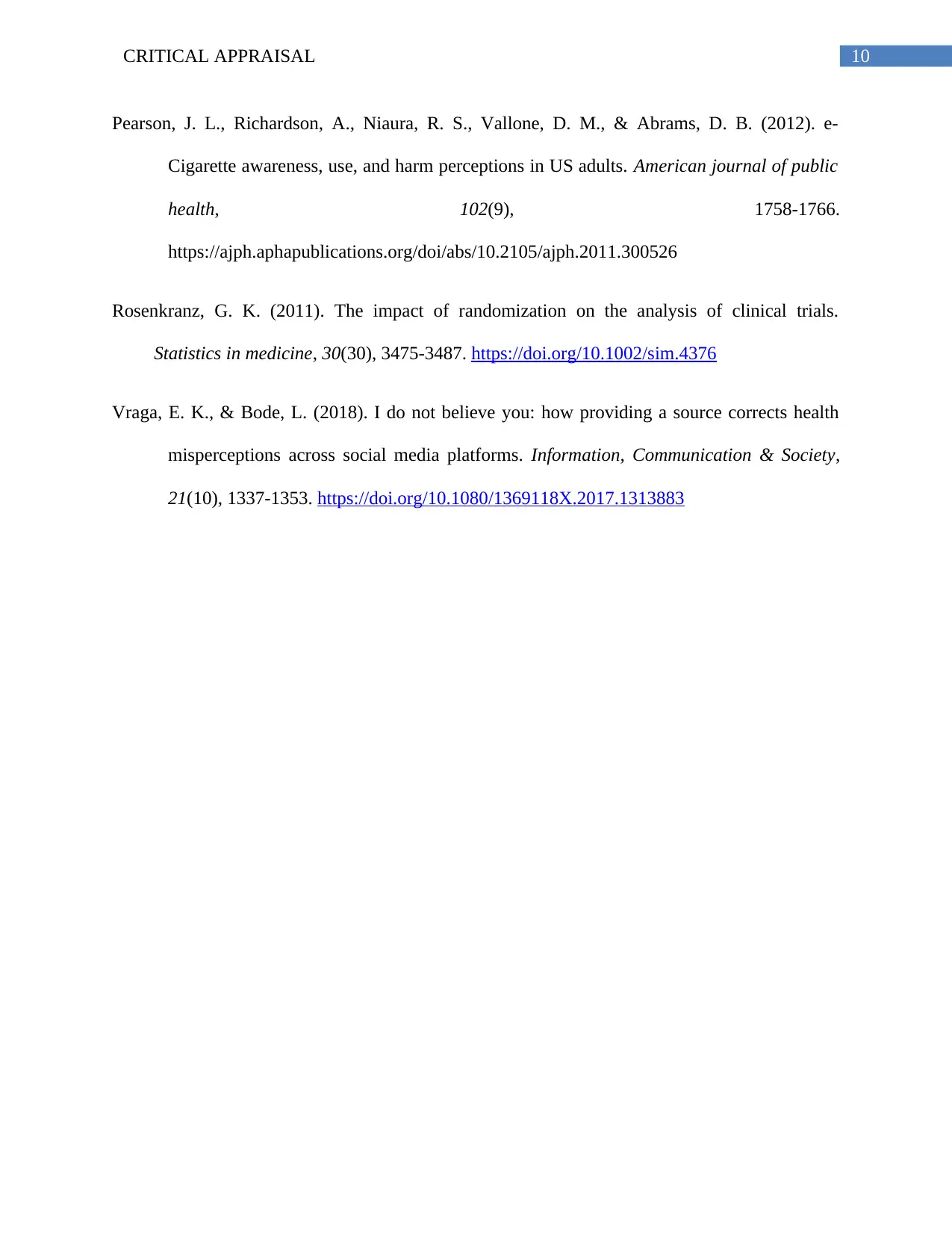
10CRITICAL APPRAISAL
Pearson, J. L., Richardson, A., Niaura, R. S., Vallone, D. M., & Abrams, D. B. (2012). e-
Cigarette awareness, use, and harm perceptions in US adults. American journal of public
health, 102(9), 1758-1766.
https://ajph.aphapublications.org/doi/abs/10.2105/ajph.2011.300526
Rosenkranz, G. K. (2011). The impact of randomization on the analysis of clinical trials.
Statistics in medicine, 30(30), 3475-3487. https://doi.org/10.1002/sim.4376
Vraga, E. K., & Bode, L. (2018). I do not believe you: how providing a source corrects health
misperceptions across social media platforms. Information, Communication & Society,
21(10), 1337-1353. https://doi.org/10.1080/1369118X.2017.1313883
Pearson, J. L., Richardson, A., Niaura, R. S., Vallone, D. M., & Abrams, D. B. (2012). e-
Cigarette awareness, use, and harm perceptions in US adults. American journal of public
health, 102(9), 1758-1766.
https://ajph.aphapublications.org/doi/abs/10.2105/ajph.2011.300526
Rosenkranz, G. K. (2011). The impact of randomization on the analysis of clinical trials.
Statistics in medicine, 30(30), 3475-3487. https://doi.org/10.1002/sim.4376
Vraga, E. K., & Bode, L. (2018). I do not believe you: how providing a source corrects health
misperceptions across social media platforms. Information, Communication & Society,
21(10), 1337-1353. https://doi.org/10.1080/1369118X.2017.1313883
1 out of 11
Related Documents
Your All-in-One AI-Powered Toolkit for Academic Success.
+13062052269
info@desklib.com
Available 24*7 on WhatsApp / Email
![[object Object]](/_next/static/media/star-bottom.7253800d.svg)
Unlock your academic potential
Copyright © 2020–2025 A2Z Services. All Rights Reserved. Developed and managed by ZUCOL.




